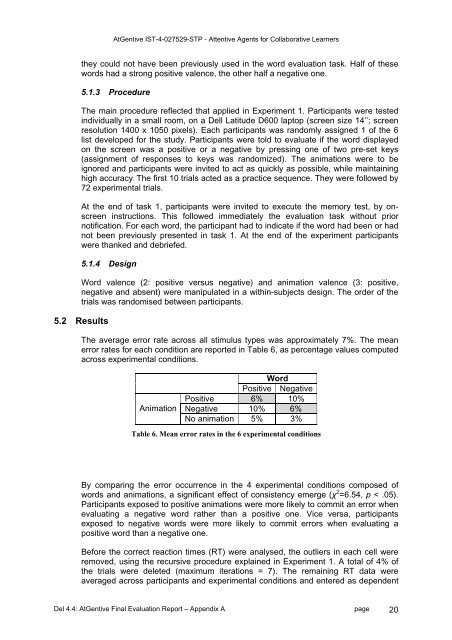Deliverable 4.4 - INSEAD CALT
Deliverable 4.4 - INSEAD CALT
Deliverable 4.4 - INSEAD CALT
You also want an ePaper? Increase the reach of your titles
YUMPU automatically turns print PDFs into web optimized ePapers that Google loves.
AtGentive IST-4-027529-STP - Attentive Agents for Collaborative Learnersthey could not have been previously used in the word evaluation task. Half of thesewords had a strong positive valence, the other half a negative one.5.1.3 ProcedureThe main procedure reflected that applied in Experiment 1. Participants were testedindividually in a small room, on a Dell Latitude D600 laptop (screen size 14’’; screenresolution 1400 x 1050 pixels). Each participants was randomly assigned 1 of the 6list developed for the study. Participants were told to evaluate if the word displayedon the screen was a positive or a negative by pressing one of two pre-set keys(assignment of responses to keys was randomized). The animations were to beignored and participants were invited to act as quickly as possible, while maintaininghigh accuracy. The first 10 trials acted as a practice sequence. They were followed by72 experimental trials.At the end of task 1, participants were invited to execute the memory test, by onscreeninstructions. This followed immediately the evaluation task without priornotification. For each word, the participant had to indicate if the word had been or hadnot been previously presented in task 1. At the end of the experiment participantswere thanked and debriefed.5.1.4 DesignWord valence (2: positive versus negative) and animation valence (3: positive,negative and absent) were manipulated in a within-subjects design. The order of thetrials was randomised between participants.5.2 ResultsThe average error rate across all stimulus types was approximately 7%. The meanerror rates for each condition are reported in Table 6, as percentage values computedacross experimental conditions.AnimationWordPositive NegativePositive 6% 10%Negative 10% 6%No animation 5% 3%Table 6. Mean error rates in the 6 experimental conditionsBy comparing the error occurrence in the 4 experimental conditions composed ofwords and animations, a significant effect of consistency emerge (χ 2 =6.54, p < .05).Participants exposed to positive animations were more likely to commit an error whenevaluating a negative word rather than a positive one. Vice versa, participantsexposed to negative words were more likely to commit errors when evaluating apositive word than a negative one.Before the correct reaction times (RT) were analysed, the outliers in each cell wereremoved, using the recursive procedure explained in Experiment 1. A total of 4% ofthe trials were deleted (maximum iterations = 7). The remaining RT data wereaveraged across participants and experimental conditions and entered as dependentDel <strong>4.4</strong>: AtGentive Final Evaluation Report – Appendix A page 20
















